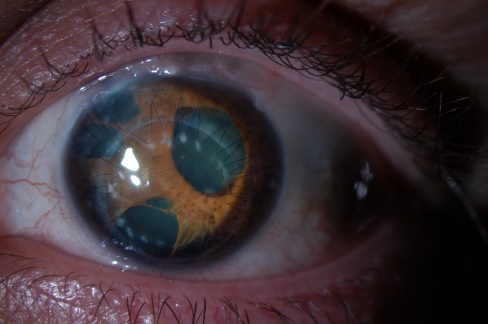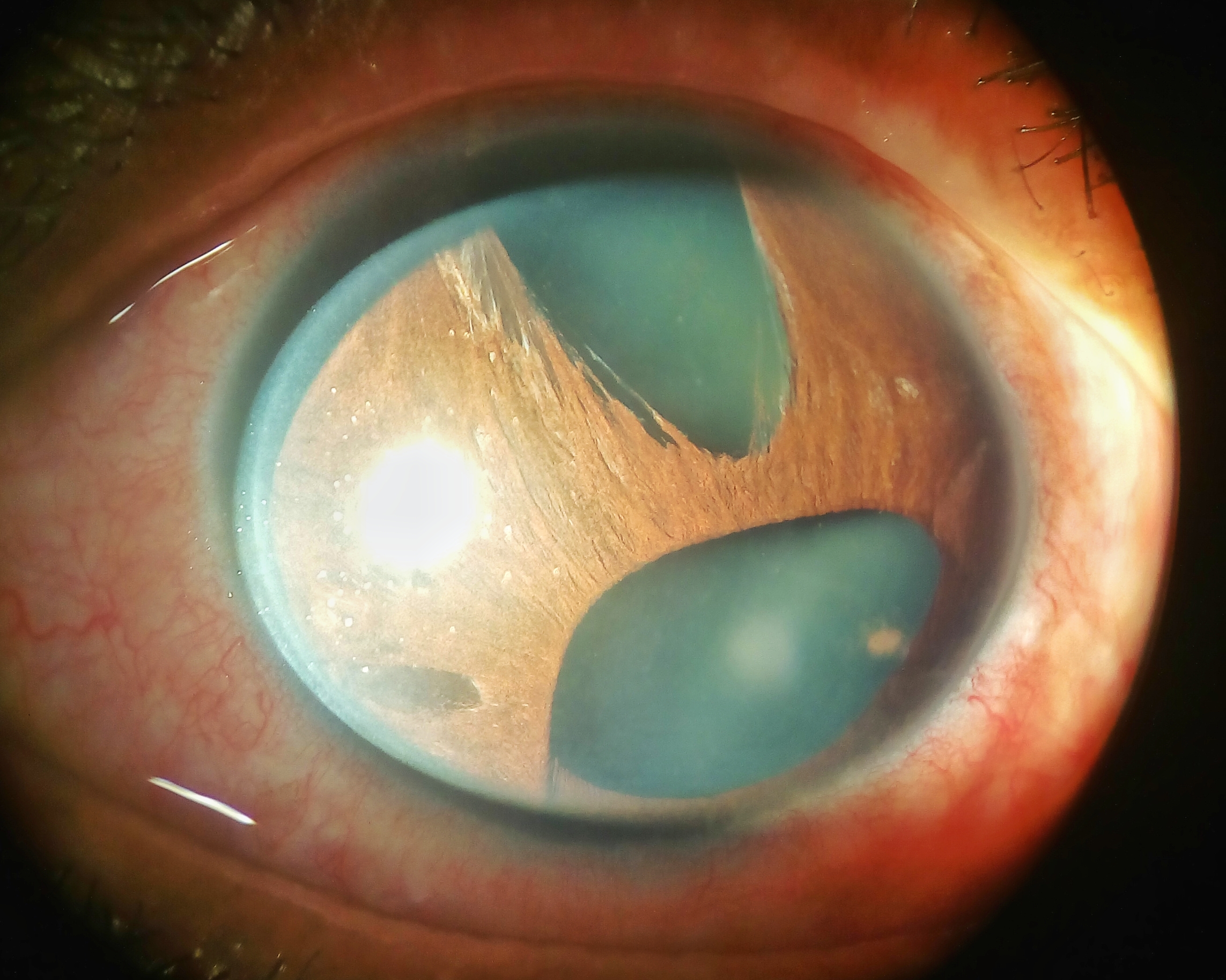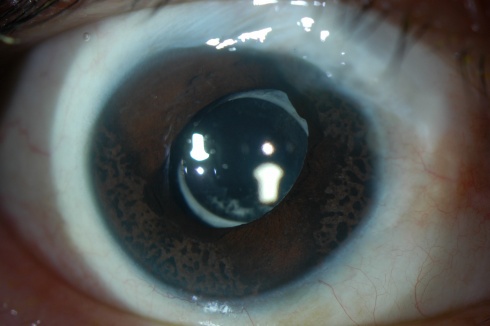Iridocorneal Endothelial Syndrome and Secondary Glaucoma
All content on Eyewiki is protected by copyright law and the Terms of Service. This content may not be reproduced, copied, or put into any artificial intelligence program, including large language and generative AI models, without permission from the Academy.
Introduction
Iridocorneal Endothelial Syndrome (ICE) syndrome is a unique ophthalmic disorder that involves an irregular corneal endothelium that can lead to varying degrees of corneal edema, iris atrophy, and secondary angle-closure glaucoma.
ICE syndrome is a group of disorders with three clinical variants:
- Chandler Syndrome
- Essential / Progressive Iris Atrophy
- Iris Nevus / Cogan-Reese Syndrome
Clinical distinction between each subtype can be made based on unique characteristics. However, each can result in substantial visual impairment from glaucomatous optic neuropathy and / or corneal edema, making management a challenge.
Pathophysiology
Clinically, the corneal endothelium has been described to have a "hammered silver" or "beaten bronze" appearance in ICE syndrome patients, similar to corneal guttae seen in Fuchs Corneal Endothelial Dystrophy.[1] [2] On a pathological level, it is felt that the normal endothelial cells have been replaced with a more epithelial-like cell with migratory characteristics. Transmission and Scanning Electron Microscopic examination of these cells has demonstrated a population of well-differentiated cells with epithelial features such as desmosomes, tonofilaments, and microvilli.[3]The altered endothelium migrates posteriorly, moving beyond Schwalbe's line, onto the trabecular meshwork, and at times, onto peripheral iris. Contraction of this tissue within the angle and on the iris results in the high peripheral anterior synechiae (PAS) and iris changes characteristic of ICE syndrome. Secondary angle-closure glaucoma is a consequence of high PAS, but can at times occur without overt synechiae because the advancing corneal endothelium can functionally close the angle without contraction.[1] As a result, patients may initially present with what appears to be open-angle glaucoma because the fibrovascular membrane obstructing aqueous flow can be difficult to visualize with gonioscopy.
The corneal edema found in ICE syndrome patients is thought to be secondary to both elevated intraocular pressure (IOP) from secondary angle-closure glaucoma, and from subnormal pump function from the altered corneal endothelial cells.[4]This can be found in any of the three clinical variants, but is more common in patients with Chandler syndrome.
Etiology
The true etiology of ICE syndrome is not well understood.[2][5] It has been theorized that an underlying viral infection with Herpes simplex virus (HSV) or Epstein-Barr virus (EBV) leads to a low grade inflammation at the level of the corneal endothelium, resulting in its unusual epithelial-like activity.[1][6] Polymerase Chain Reaction (PCR) testing of corneal endothelial cells from ICE syndrome patients has been found to have high percentages of HSV DNA in comparison to normal controls.[6] Additionally, HSV DNA was found in samples of the aqueous humor .[7] These abnormal cells may also cause toxic injury to surrounding normal endothelial cells, evidenced by necrotic damage to neighboring cells seen on electron microscopy.[8]
Epidemiology
ICE syndrome is considered sporadic in presentation, with no consistent association to other ocular or systemic disease, and familial cases have been very rare. It presents as a unilateral disease, more common in women, between the ages of 20 and 50.[1] ICE syndrome must be considered within the differential diagnosis for any young to middle-aged patient presenting with unilateral glaucoma, corneal decompensation, and / or iris atrophy.
Clinical diagnosis and evaluation
The initial presentation of ICE syndrome patients may be due to monocular pain (from corneal edema or elevated intraocular pressure from angle-closure), blurry vision, or iris changes. Patients require a full ophthalmic work-up, with assessment of visual acuity and refractive error, intraocular pressure, and slit-lamp examination, dilated fundus examination, and gonioscopic examination. Close evaluation of the cornea should be done to assess for corneal edema and corneal endothelial irregularity (a 'beaten bronze' or 'hammered silver' appearance when viewed in specularly reflected light with the slit lamp).[5] Iris changes (such as heterochromia, ectropion uveae, corectopia, hole formation, and iris atrophy) may be evident on slit-lamp examination. Exam with gonioscopy may show high PAS extending above Schwalbe line, which is pathognomonic for ICE syndrome.[1]
Distinction can be made between the three clinical variants based on clinical exam:
Chandler Syndrome:
This is the most common of the three sub-types, representing approximately 50% of all cases of ICE syndrome.[1] Of the three, Chandler Syndrome typically presents with a greater degree of corneal pathology with associated corneal edema. The edema can be microcystic, even with a normal intraocular pressure (this is common of all three variants). The iris findings are less common, and a majority of patients have no iris changes at all, making the diagnosis a challenge.
Essential / Progressive Iris Atrophy:
The iris findings of this variant can be quite robust and progressive over time. Polycoria, corectopia, iris hole formation, ectropion uveae, and iris atrophy are all common findings at the time of examination.

Iris Nevus / Cogan-Reese Syndrome:
This variant of ICE syndrome is distinguished by its unique iris findings. The anterior surface of iris has tan pedunculated nodules or diffuse pigmented lesions.[1] However, iris atrophy is uncommon with these particular patients.
Diagnostic testing
Specular microscopy is an important diagnostic tool, as the corneal endothelium has a characteristic appearance in ICE syndrome patients. ICE cells are characterized by loss of the typical hexagonal corneal endothelium shape, pleomorphic appearance, and “ light-dark reversal “ on specular microscopy.[9][8] Asymmetric endothelial cell loss and atypical endothelial cell morphology is typically evident, which appears on a specular photomicrograph as dark, larger than normal endothelial cells, with a bright central spot.[5] This is referred to as the "light-dark reversal." The endothelial cells have also been described to appear as dark areas with central highlights and light peripheral borders.[4][10] These corneal endothelial cells are felt to be pathognomonic for ICE syndrome, and have hence been referred to as "ICE cells" when seen on specular photomicrographs.[10] Resulting corneal edema can be quantified with a pachymeter at each visit.
Routine evaluation for glaucoma in these patients should be done by measuring intraocular pressure and evaluating the angle for PAS with gonioscopy. Greater diagnostic evaluation for glaucoma can be accomplished with common testing devices utilized for any glaucoma patient. Stereo disc photographs and visual field analysis (Humphrey or Goldmann), along with optic nerve and nerve fiber layer assessment (heidelberg retinal tomogram (HRT) or optical coherence tomography (OCT)), can all be implemented in the initial work-up and ongoing evaluation for glaucoma progression in these patients.
Differential diagnosis
Iridocorneal endothelial syndrome (ICE)
- Cogan-Reese syndrome
- Chandler syndrome
- Essential iris atrophy
Posterior polymorphous corneal dystrophy (PPMD)
This endothelial corneal dystrophy is an autosomal dominant disease that is similar to ICE syndrome on microscopic examination, with multilayered endothelial cells that look and behave like epithelial cells or fibroblasts.[4] Also, patients with PPMD may have variable amounts of corectopia, corneal edema, iridocorneal adhesions, and can present with both angle-closure or open-angle glaucoma. The easiest differentiating factor is that PPMD is inherited and is bilateral, whereas ICE syndrome is sporadic and unilateral. Additionally, the two differ on specular microscopy testing. ICE syndrome endothelial cells appear as dark areas with central highlights and light peripheral borders, whereas PPMD shows typical vesicles and bands on specular microscopy.[4]
Axenfeld-Rieger Syndrome (ARS)
Axenfeld-Rieger syndrome is a bilateral, heterogeneous congenital condition that is is autosomal dominant in most cases, but can also occur sporadically, and may include developmental abnormalities in the anterior chamber angle, iris, and trabecular meshwork. Corectopia, polycoria, ectropion uveae, posterior embryotoxon, and increased intraocular pressure are common ophthalmologic findings with ARS.[11] Again, the fact that ICE syndrome is only sporadic and unilateral allows for easy differentiation of the two ocular diseases. Additionally, ARS is congenital with patients presenting at a young age, can have systemic findings, and does not have corneal endothelial changes.
Aniridia (Iris Hypoplasia)
Aniridia is a bilateral congenital disease that presents with absence of the iris (commonly a rudimentary iris stump exists), cataracts, glaucoma, and corneal pannus. In addition, patients may have foveal and optic nerve hypoplasia, with poor visual acuity (less than 20/100), nystagmus, and strabismus. A defect in the PAX6 gene on band 11p13, which can be sporadic or familial (autosomal dominant), results in congenital ocular malformations and corneal stem cell deficiency.[12] A unique angle-closure glaucoma may develop (50-75% of cases), typically in the second decade of life, which is a direct result from rotation of the rudimentary iris into the anterior chamber angle. The congenital cataracts, optic nerve and foveal hypoplasia, bilateral presentation, lack of corneal endothelial changes, and congenital nature differentiate aniridia from ICE syndrome.
Management
The treatment of ICE syndrome, regardless of the variant, primarily revolves around the prevention of glaucomatous vision loss secondary to elevated intraocular pressure. Additionally, treatment of corneal edema and other corneal changes is vital to maintain high quality visual acuity. Both ocular hypertension and corneal decompensation can be addressed with medical and surgical treatment approaches.
Medical therapy
Topical medication is the first line therapy for patients with elevated intraocular pressure from secondary angle-closure glaucoma in the setting of ICE syndrome.[2] More specifically, aqueous suppressants (such as topical beta blockers, alpha agonists, and carbonic anhydrase inhibitors) are typically used, rather than medications that would target the aqueous drainage sites of the eye (e.g. miotics). The role of prostaglandin analogs, which reduce intraocular pressure by enhancing uveoscleral outflow, remains unclear.[1] Because of the theorized role of HSV in ICE, the addition of prostaglandins should be carefully considered due to reports of latanoprost-induced HSV recurrence. [13]
Corneal edema in ICE syndrome patients may be exacerbated by elevated IOP, and these corneal changes may benefit from the reduction of IOP by topical aqueous suppressants as well. Additionally, topical hypertonic saline solutions and gels can be utilized to improve corneal edema by dehydrating the cornea.
Surgical therapy
When medical therapy is unsuccessful at controlling IOP, surgical therapy with a filtering procedure may be necessary. A trabeculectomy with antifibrotic agents (mitomycin-C or 5-fluorouracil) or a glaucoma drainage device (aqueous shunt) have been found to be effective in controlling IOP in ICE syndrome patients.[2][5] However, maintaining long-term success can be challenging, as the fistula and trabecular meshwork can be obstructed with advancing abnormal corneal endothelial cells[14]. Nd:YAG laser may be utilized to reopen blocked glaucoma tube shunts. Long-term surgical outcomes have been reported to be slightly better with glaucoma drainage implants (survival of 71% at 1 year, 71% at 3 years, and 53% at 5 years) versus trabeculectomy with antifibrotic agents (survival of 73% at 1 year, 44% at 3 years, and 29% at 5 years).[15] Regardless of the procedure, it has been noted that these patients typically require multiple surgeries to maintain stable IOP control.[15]If surgical success is not obtained with a trabeculectomy or glaucoma drainage device, it may be necessary to treat patients with a ciliary body destruction procedure. Often, this may be required due to the difficult to control nature of ICE syndrome intraocular pressure. Typically this is done with diode laser cyclophotocoagulation (diode CPC), and is reserved for intractable cases of glaucoma.
Corneal decompensation can similarly be treated with surgery when medical management fails. Penetrating keratoplasty (PKP) or endothelial keratoplasty (commonly DSEK or DSAEK) can be implemented to replace the abnormal corneal endothelial cells and improve corneal function.[1][2][4] At times, both a filtering and corneal transplant procedure are necessary. Concomitant control of IOP is vital for maintenance of corneal graft clarity.
Complications
Glaucomatous optic neuropathy
ICE syndrome can result in advanced glaucomatous optic neuropathy with extensive vision loss if left untreated. Glaucoma occurs in approximately 50% of patients with ICE syndrome and tends to be more severe in progressive iris atrophy and Cogan-Reese syndrome.[1] Glaucoma is a result of trabecular meshwork obstruction from migrating dysfunctional corneal endothelial cells.[5] High PAS may develop within the angle after contraction of this membrane, making the diagnosis of secondary angle-closure glaucoma simple with gonioscopy. However, a 'functional' angle-closure (that can be confused with open-angle glaucoma) may exist because the endothelial cell membrane can advance without causing overt synechial formation.[1]
Corneal edema and decompensation
Poor vision secondary to corneal endothelial cell dysfunction with resulting corneal decompensation and edema is common in patients with ICE syndrome. Mild cases can be managed with topical hypertonic saline drops and ointments. Severe cases may require corneal transplant surgery (Penetrating Keratoplasty (PKP) or Descemet's Stripping Endothelial Keratoplasty (DSAEK or DSEK)). This complication has been found to be more profound in Chandler Syndrome.
Iris changes (atrophy, corectopia, polycoria, ectropion uveae)
Contraction of corneal endothelial cells that have advanced on to the iris can result in these degenerative changes. Patients with good visual potential may develop visual distortion and glare from these iris changes. This complication is most pronounced in Essential Iris Atrophy / Progressive Iris Atrophy.
Failed glaucoma surgery
Late failures have been reported with trabeculectomies secondary to advancing endothelialization of the fistula. In some cases these can be treated with a Nd:YAG laser procedure to re-open the fistula.[5]
Prognosis
Prognosis for patients with ICE syndrome depends on whether the above complications develop. This is dependent on the timing of diagnosis within the disease course, and the success or failure of treatment. Many patients have subtle disease, and do quite well with intraocular pressure control (both topical and surgical). However, there are rare patients with aggressive disease who suffer from extensive vision loss from advanced glaucoma and / or corneal edema. The glaucoma tends to be more severe in progressive iris atrophy and Cogan-Reese syndrome.[1] If surgical intervention is required for intraocular pressure control, the prognosis tends to be more guarded.
Additional Resources
- Axenfeld-Rieger Syndrome
- Trabeculectomy
- Glaucoma Drainage Devices
- Penetrating Keratoplasty (PKP)
- Endothelial Keratoplasty
- Primary vs. Secondary Angle Closrure Glaucoma
- Boyd K, DeAngelis KD. Iridocorneal Endothelial Syndrome . American Academy of Ophthalmology. EyeSmart/Eye health. https://www.aao.org/eye-health/diseases/iridocorneal-endothelial-syndrome-5. Accessed March 13, 2019.
Acknowledgements
All Images are Courtesy of The Krieger Eye Institute (KEI) at Sinai Hospital of Baltimore, along with Dr. Donald Abrams and Dr. Gregory Oldham.
References
- ↑ Jump up to: 1.00 1.01 1.02 1.03 1.04 1.05 1.06 1.07 1.08 1.09 1.10 1.11 Glaucoma. Basic and Clinical Science Course (BCSC). American Academy of Ophthalmology, 2010-2011; pp142-144.
- ↑ Jump up to: 2.0 2.1 2.2 2.3 2.4 Doan A, Alward W: Iridocorneal Endothelial Syndrome (ICE) - essential iris atrophy : 63 year-old female with PAS, "iris mass", corectopia, and increased IOP OS. February 21, 2005; Available from: http://www.EyeRounds.org/cases/case14.htm.
- ↑ Levy SG, Kirkness CM, Moss J, Ficker L, McCartney AC. The histopathology of the iridocorneal-endothelial syndrome. Cornea. 1996 Jan;15(1):46-54.
- ↑ Jump up to: 4.0 4.1 4.2 4.3 4.4 External Disease and Cornea. Basic and Clinical Science Course (BCSC). American Academy of Ophthalmology, 2010-2011; pp344-345.
- ↑ Jump up to: 5.0 5.1 5.2 5.3 5.4 5.5 Laganowski HC, Kerr Muir MG, Hitchings RA. Glaucoma and the iridocorneal endothelial syndrome. Arch Ophthalmol. 1992 Mar;110(3):346-50.
- ↑ Jump up to: 6.0 6.1 Alvarado JA, Underwood JL, Green WR, et al. Detection of herpes simplex viral DNA in the iridocorneal endothelial syndrome. Arch Ophthalmol. Dec 1994;112(12):1601-9. [Medline].
- ↑ Groh MJ, Seitz B, Schumacher S, Naumann GO. Detection of herpes simplex virus in aqueous humor in iridocorneal endothelial (ICE) syndrome. Cornea. 1999;18(3):359-360.
- ↑ Jump up to: 8.0 8.1 Levy SG, McCartney AC, Baghai MH, Barrett MC, Moss J. Pathology of the iridocorneal-endothelial syndrome. The ICE-cell. Invest Ophthalmol Vis Sci. 1995;36(13):2592-2601
- ↑ Feng, B., Tang, X., Chen, H., Sun, X., & Wang, N. (2018). Unique variations and characteristics of iridocorneal endothelial syndrome in China: a case series of 58 patients. International Ophthalmology, 38, 2117-2126.
- ↑ Jump up to: 10.0 10.1 Laganowski HC, Sherrard ES, Muir MG, and Buckley RJ. Distinguishing features of the iridocorneal endothelial syndrome and posterior polymorphous dystrophy: value of endothelial specular microscopy. Br J Ophthalmol. 1991 April; 75(4): 212–216.
- ↑ Axenfeld Rieger Syndrome. Eye Wiki. Available from: https://eyewiki.aao.org/Axenfeld_Rieger_Syndrome
- ↑ Pediatric Ophthalmology and Strabismus. Basic and Clinical Science Course (BCSC). American Academy of Ophthalmology, 2010-2011; pp223-224.
- ↑ Wand M., Gilbert C. M., Liesegang T. J. Latanoprost and herpes simplex keratitis. American Journal of Ophthalmology. 1999;127(5):602–604. doi: 10.1016/s0002-9394(99)00050-1
- ↑ Patel A., Kenyon K. R., Hirst L. W., et al. Clinicopathologic features of Chandler's syndrome. Survey of Ophthalmology. 1983;27(5):327–344. doi: 10.1016/0039-6257(83)90234-5.
- ↑ Jump up to: 15.0 15.1 Doe EA, Budenz DL, Gedde SJ, Imami NR. Long-term surgical outcomes of patients with glaucoma secondary to the iridocorneal endothelial syndrome. Ophthalmology. 2001 Oct;108(10):1789-95.
- Aung T. Iridocorneal Endothelial Syndrome. Asian Journal of Ophthalmology and Asia-Pacific Journal of Ophthalmology. Volume 2, Number 1, 2. 2000.



